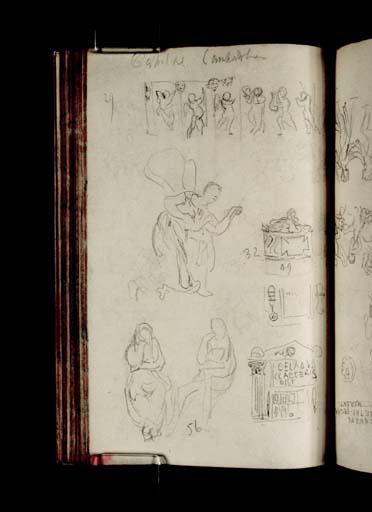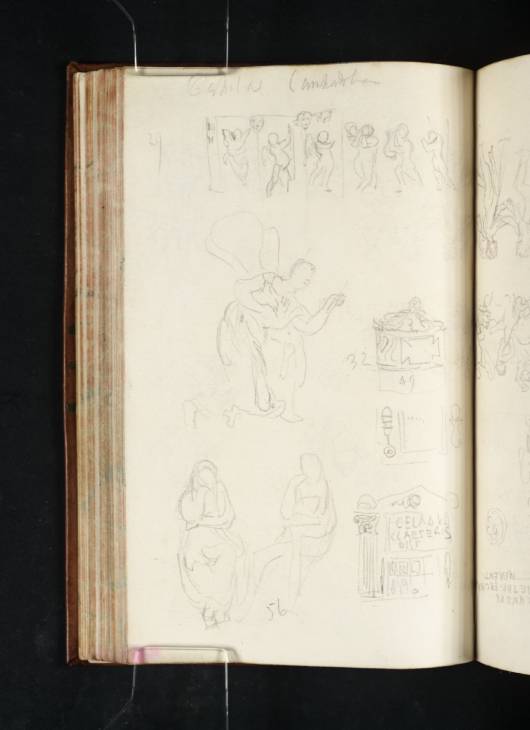Joseph Mallord William Turner Studies of Sculptural Fragments from the Galleria of the Palazzo Nuovo in the Capitoline Museums, Rome 1819
Image 1 of 2
-
 Joseph Mallord William Turner, Studies of Sculptural Fragments from the Galleria of the Palazzo Nuovo in the Capitoline Museums, Rome 1819
Joseph Mallord William Turner, Studies of Sculptural Fragments from the Galleria of the Palazzo Nuovo in the Capitoline Museums, Rome 1819 -
 Joseph Mallord William Turner, Studies of Sculptural Fragments from the Galleria of the Palazzo Nuovo in the Capitoline Museums, Rome 1819 (Enhanced image)Enhanced image
Joseph Mallord William Turner, Studies of Sculptural Fragments from the Galleria of the Palazzo Nuovo in the Capitoline Museums, Rome 1819 (Enhanced image)Enhanced image
Joseph Mallord William Turner,
Studies of Sculptural Fragments from the Galleria of the Palazzo Nuovo in the Capitoline Museums, Rome
1819
Joseph Mallord William Turner 1775–1851
Folio 53 Verso:
Studies of Sculptural Fragments from the Galleria of the Palazzo Nuovo in the Capitoline Museums, Rome 1819
D15207
Turner Bequest CLXXX 52 a
Turner Bequest CLXXX 52 a
Pencil on white wove paper, 161 x 101 mm
Inscribed by the artist in pencil ‘Capital Campadola’ top and other (see main catalogue entry)
Accepted by the nation as part of the Turner Bequest 1856
References
1909
A.J. Finberg, A Complete Inventory of the Drawings of the Turner Bequest, London 1909, vol.I, p.533, as ‘Figures, &c., including Nos. “29”, “32”, “49” and “56” – “Capital Campadola” ’.
1984
Cecilia Powell, ‘Turner on Classic Ground: His Visits to Central and Southern Italy and Related Paintings and Drawings’, unpublished Ph.D thesis, Courtauld Institute of Art, University of London 1984, pp.117, 129, 419, 476 note 9, 482 note 67, reproduced pl.72, as ‘Capitol Campidolia (i.e. the Capitoline) (a) the erotes in panels from the octagonal cinerarium of D. Lucilius Felix (J, pl.26, 10, 1–3) (b) Psyche (J, pl.19, 20) (c) Cinerarium of the Valerii (J, pl.33, 18) (d) Fragmentary cinerarium of C. Larinas Atticus (J, pl.34A, 43a) (e) Two sketches of a seated female statue known as Julia Pia (J, pl.20, 42), (f) Cinerarium of Celadus C. Caeseris (sic) (J, pl.33, 35a)’.
1987
Cecilia Powell, Turner in the South: Rome, Naples, Florence, New Haven and London 1987, pp.43–4 note 18, 51 note 7, 58 note 38.
2008
James Hamilton, Nicola Moorby, Christopher Baker and others, Turner e l’Italia, exhibition catalogue, Palazzo dei Diamanti, Ferrara 2008, pp.47, 91 note 50.
2009
James Hamilton, Nicola Moorby, Christopher Baker and others, Turner & Italy, exhibition catalogue, National Galleries of Scotland, Edinburgh 2009, pp.47, 151 note 50.
In addition to sketching in the Vatican Museums, Turner made a thorough study of the ancient Greek and Roman sculptures in the Palazzo Nuovo of the Capitoline Museums. The drawings on this page represent works from the Galleria (Gallery), a long connecting room on the first floor, which contains a variety of statues, portraits, reliefs and inscriptions, many of which are still displayed in their original eighteenth-century arrangement. All of the subjects were first identified by Cecilia Powell. The studies are numbered from top left to bottom right:
a.
The sketch at the top of the page represents part of the octagonal cinerarium (ash urn) of D. Lucilius Felix.1 The object is decorated with a sculptural relief of amorini and masks. Turner has annotated the drawing with the number ‘29’.
b.
The sketch on the left-hand side of the second row depicts a winged statue of Psyche, a Roman copy of a Greek original, from the Villa d’Este, Tivoli which was only moved to the gallery in 1817.2 Powell has suggested that Turner has amalgamated features from oblique and frontal views of the sculpture, so that her wings and left arm both appear at their most extended and she is therefore represented at her most graceful.3 The drawing is annotated with the number ‘32’.
c.
The sketch on the right-hand side of the second row depicts a cinerarium with a funerary inscription to Valeria Herius and M. Valerius Hermes.4 Turner has annotated the drawing with the number ‘49’.
d.
The sketch on the right-hand side of the third row depicts part of cinerarium with a funerary inscription to C. Larinas Atticus.5
e.
The two sketches in the bottom left-hand corner depict variant views of a statue of a seated woman, formerly known as Julia Pia.6 The object was found on the Via Appia near the Church of Quo Vadis in 1817 and purchased for the museum the following year. Turner has annotated the drawing with the number ‘56’.
f.
The sketch in the bottom right-hand corner represents the cinerarium of Celadus.7 Turner has transcribed the Latin inscription ‘CELADVS | CCAESERIS | DISP’.
The sketch at the top of the page represents part of the octagonal cinerarium (ash urn) of D. Lucilius Felix.1 The object is decorated with a sculptural relief of amorini and masks. Turner has annotated the drawing with the number ‘29’.
b.
The sketch on the left-hand side of the second row depicts a winged statue of Psyche, a Roman copy of a Greek original, from the Villa d’Este, Tivoli which was only moved to the gallery in 1817.2 Powell has suggested that Turner has amalgamated features from oblique and frontal views of the sculpture, so that her wings and left arm both appear at their most extended and she is therefore represented at her most graceful.3 The drawing is annotated with the number ‘32’.
c.
The sketch on the right-hand side of the second row depicts a cinerarium with a funerary inscription to Valeria Herius and M. Valerius Hermes.4 Turner has annotated the drawing with the number ‘49’.
d.
The sketch on the right-hand side of the third row depicts part of cinerarium with a funerary inscription to C. Larinas Atticus.5
e.
The two sketches in the bottom left-hand corner depict variant views of a statue of a seated woman, formerly known as Julia Pia.6 The object was found on the Via Appia near the Church of Quo Vadis in 1817 and purchased for the museum the following year. Turner has annotated the drawing with the number ‘56’.
f.
The sketch in the bottom right-hand corner represents the cinerarium of Celadus.7 Turner has transcribed the Latin inscription ‘CELADVS | CCAESERIS | DISP’.
Turner has inscribed some of his studies with the contemporary exhibit numbers of the objects. These date from 1816 when the return to Rome of works spoliated by Napoleon occasioned a complete reorganisation of the Capitoline Museums. The new arrangement was first published in Agostino Tofanelli’s, Catalogo delle sculture antiche e de’quadri esistenti nel Museo e Galleria da Campidoglio (1817) and the same numbering system can be found within a near-contemporaneous view of the gallery, James Hakewill’s (1778–1843) drawing, Rome. Antiques of the Capitol. Gallery 1817 (British School at Rome Library), and the related print published in Picturesque Tour in Italy, 1818.8 The winged statue of Psyche and the octagonal cinerarium of D. Lucilius Felix can both be seen, facing each other across opposite sides of the gallery in the centre of the sketch.
Powell has suggested that Turner may have adapted the cupid figures from the octagonal cinerarium and transformed them into the free-standing statue group visible in the finished oil painting, What You Will! exhibited 1822 (Sterling and Francine Clark Art Institute, Williamstown, Massachusetts).9
Nicola Moorby
November 2009
Powell 1984, p.419; H. Stuart Jones, A Catalogue of the Ancient Sculptures preserved in the Municipal Collections of Rome. The Sculptures of the Museo Capitolino, Oxford 1912, ‘Galleria’ no.10, p.91, reproduced pl.26. See also the Capitoline Museums online collection records, http://www.museicapitolini.net/urn?urn=urn:collectio:0001:scu:00297 , accessed November 2009.
Powell 1984, p.419; Jones 1912, ‘Galleria’ no.20, p.98, reproduced pl.19; see also http://www.museicapitolini.net/urn?urn=urn:collectio:0001:scu:00287 .
Powell 1984, p.419; Jones 1912, ‘Galleria’ no.18, p.97, reproduced pl.33; see also http://www.museicapitolini.net/urn?urn=urn:collectio:0001:scu:00289 .
Powell 1984, p.419; Jones 1912, ‘Galleria’ no.43a, p.116, reproduced pl.34a; see also http://www.museicapitolini.net/urn?urn=urn:collectio:0001:scu:01910 .
Powell 1984, p.419; Jones 1912, ‘Galleria’ no.42, p.115, reproduced pl.20; see also http://www.museicapitolini.net/urn?urn=urn:collectio:0001:scu:00264 .
Powell 1984, p.419; Jones 1912, ‘Galleria’ no.35a, p.111, reproduced pl.33; see also http://www.museicapitolini.net/urn?urn=urn:collectio:0001:scu:01915 .
See Tony Cubberley and Luke Herrmann, Twilight of the Grand Tour: A Catalogue of the drawings by James Hakewill in the British School at Rome Library, Rome 1992, no.5M.28, reproduced p.327.
How to cite
Nicola Moorby, ‘Studies of Sculptural Fragments from the Galleria of the Palazzo Nuovo in the Capitoline Museums, Rome 1819 by Joseph Mallord William Turner’, catalogue entry, November 2009, in David Blayney Brown (ed.), J.M.W. Turner: Sketchbooks, Drawings and Watercolours, Tate Research Publication, December 2012, https://www

